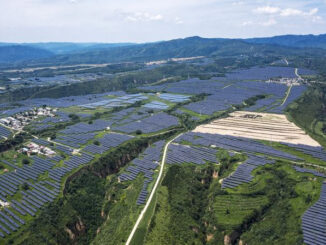
In an era where artificial intelligence (AI) and data centers are transforming the energy landscape, America’s power grid faces a silent yet potentially devastating threat: a fragile supply chain plagued by bottlenecks, foreign dependencies, and security risks. As demand for electricity surges to unprecedented levels, critical components like transformers and natural gas generators are in short supply, delaying new power plants, prolonging the life of aging coal facilities, and exposing the nation to blackouts or worse. This overlooked vulnerability isn’t just about logistics—it’s a national security imperative, compounded by eroding trust in foreign suppliers, particularly China. Drawing from recent analyses, this article explores these issues and underscores the urgent need for secure, American-made solutions.
The Transformer Crisis: A Bottleneck in the Heart of the Grid
Transformers are the unsung heroes of the electric grid, stepping up or down voltage to ensure power flows efficiently from generation sources to homes, businesses, and data centers. Yet, supply chain disruptions have ballooned lead times for these essential devices from around 50 weeks in 2021 to an average of 127 weeks today, with some specialized units taking up to four years.
This shortage stems from global demand spikes driven by aging infrastructure, renewable energy expansions, electrification trends, electric vehicle (EV) charging networks, and the explosive growth of AI data centers.
The U.S. produces only about 20% of the transformers and related equipment needed for its electrical power and transmission systems, leaving the country heavily reliant on imports, primarily from Canada, Mexico, and other foreign sources.
Prices have skyrocketed 60-80% since January 2020, and persistent supply chain challenges are impacting grid reliability, as highlighted in the North American Electric Reliability Corporation’s (NERC) 2025 Reliability Risk Priorities Report.
Vulnerabilities extend beyond delays; transformers are susceptible to electromagnetic pulses (EMPs) from solar storms or adversarial attacks, potentially causing widespread blackouts.
Recent wildfires in California have already destroyed thousands of transformers, underscoring how natural disasters could compound these issues.In the context of national security, the transformer shortage poses a “severe supply crunch” that threatens grid stability, according to experts.
The Build America, Buy America Act mandates domestic content for federally funded projects, but limited U.S. manufacturing capacity hinders compliance and exacerbates risks.
Natural Gas Generators and Power Plants: Delays Amid Surging Demand
Natural gas has long been a reliable backbone for U.S. power generation, but supply chain hurdles are now stalling new plants and complicating the extension of existing ones. A key issue is the shortage of gas turbines, critical components for natural gas-fired generators. Lead times for these turbines have stretched to years, mirroring the transformer crisis and slowing construction of new facilities.
This bottleneck is particularly acute as utilities scramble to meet rising electricity needs. The Federal Energy Regulatory Commission (FERC) warns in its 2025 Summer Energy Market and Electric Reliability Assessment that supply chain disruptions could affect response capabilities during peak demand periods.
For coal plants, many of which are slated for retirement, these issues mean extended service lives despite environmental pressures, as replacements lag. Retirements of coal and some natural gas plants are reducing baseload supply just as demand escalates, creating a precarious balance.
Geopolitical tensions and economic shifts further complicate matters. The Mott MacDonald report on managing supply chain risks in the U.S. energy market notes evolving challenges, including material shortages and workforce constraints, that delay natural gas infrastructure projects.
NERC’s report emphasizes that dependencies on natural gas supply chains heighten risks to bulk power system (BPS) continuity.
AI and Data Centers: Fueling an Energy Demand Explosion
The rise of AI is supercharging electricity consumption, with data centers projected to more than double their global demand to around 945 terawatt-hours (TWh) by 2030.
In the U.S., these facilities create concentrated, 24/7 power loads that strain grids, often requiring new or upgraded natural gas plants for reliable backup.
However, supply chain issues for transformers, generators, and turbines are limiting growth, with hyperscalers facing delays due to limited chips, electricity, and land.
Utilities are investing billions—$6.1 billion in transmission lines and a 23% increase in transformer spending since 2022—to accommodate this, but backlogs persist.
Some data centers are bypassing the grid altogether with on-site generation, including natural gas, to avoid delays.
This surge could lead to higher prices and blackouts if not addressed, as AI workloads outpace infrastructure.
The Center for Strategic and International Studies (CSIS) identifies electricity supply as the most binding constraint on U.S. AI dominance.
Loss of Trust in China and the Push for Secure Domestic ProductionCompounding these logistical woes are security concerns tied to foreign suppliers. In 2025, revelations of undocumented communication devices—such as rogue cellular radios—in Chinese-made solar inverters and wind turbine components from firms like Huawei and Sungrow eroded global trust.
These “kill switches” could enable remote sabotage, espionage, or grid disruptions, violating China’s National Intelligence Law that mandates cooperation with state intelligence.
The fallout has been swift: Western nations, including the U.S., imposed tariffs, subsidies for domestic production, and bans on high-risk components, predicting a 20-30% drop in China’s export market share by 2030.
This decoupling extends to transformers and generators, where U.S. imports exceed 80% annually.
The Department of Energy (DOE) advocates for resilient domestic supply chains, aiming to boost large power transformer production to 50% by 2029.
Legislation like the Decoupling from Foreign Adversarial Battery Dependence Act and initiatives under the Inflation Reduction Act (IRA) signal a shift, but experts call for replacing the IRA with policies like FUEL-AI to prioritize natural gas, coal, and domestic manufacturing amid AI growth.
The Critical Manufacturing Sector, as defined by the Cybersecurity and Infrastructure Security Agency (CISA), emphasizes protecting U.S. industries from such vulnerabilities.
A Call to Action: Building a Secure, Resilient Grid
America’s grid stands at a crossroads. With transformer and generator shortages delaying critical infrastructure, and AI data centers amplifying demand, the risks of blackouts, cyberattacks, or EMP events loom large. The loss of trust in Chinese suppliers serves as a wake-up call: relying on foreign equipment isn’t just inefficient—it’s dangerous. To mitigate this, the U.S. must accelerate domestic manufacturing of energy equipment, leveraging policies like Build America, Buy America to foster secure supply chains.
Investments in reshoring, as manufacturers slowly ramp up U.S. capacity despite demand uncertainties, are a start. A key strategy is to contract experts who can set up and design microgrids to help businesses grow and sustain themselves through the crisis. The traditional approach to power needs to be reevaluated by every CEO moving forward.
By prioritizing American-made products, we can safeguard our grid, support jobs, and ensure energy security for the AI-driven future. Failure to act could cripple the nation’s power—and its progress.
Is Oil & Gas Right for Your Portfolio?
Crude Oil, LNG, Jet Fuel price quote
ENB Top News
ENB
Energy Dashboard
ENB Podcast
ENB Substack






